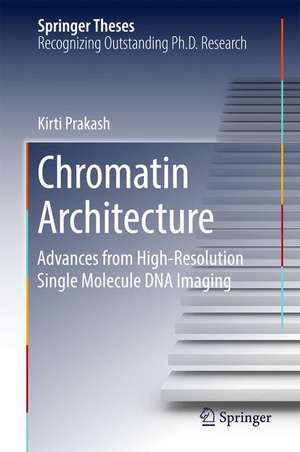Chromatin Architecture: Advances From High-resolution Single Molecule DNA Imaging: Springer Theses
Autor Kirti Prakashen Limba Engleză Hardback – 2 mar 2017
From the early work on chromosomes by Walther Flemming in the nineteenth century to recent advances in genomics, the history of chromatin research now spans more than a century. The various milestones, such as the discovery of the double helix structure, the sequencing of the human genome, and the recent description of the genome in 3D space, show that understanding chromatin and chromosome function requires a clear understanding of its structure.
Presenting cutting-edge data from super-resolution single molecule microscopy, the book demonstrates that chromatin manifests several levels of folding, from nucleosomes to chromosomes. Chromatin domains emerge as a new fundamental building block of chromatin architecture, with functions possibly related to gene regulation.
A detailed description of chromatin folding in the pachytene stage of meiosis serves as a model for exploring this functionality, showing the apparent interplay between structure, function, and epigenetic regulation. Lastly, the book discusses possible new avenues of innovation to describe chromatin’s organization and functions.
Gathering essential insights on chromatin architecture, the book offers students an introduction to microscopy and its application to chromatin organization, while also providing advanced readers with new ideas for future research.
| Toate formatele și edițiile | Preț | Express |
|---|---|---|
| Paperback (1) | 636.12 lei 43-57 zile | |
| Springer International Publishing – 18 iul 2018 | 636.12 lei 43-57 zile | |
| Hardback (1) | 642.18 lei 43-57 zile | |
| Springer International Publishing – 2 mar 2017 | 642.18 lei 43-57 zile |
Din seria Springer Theses
- 18%
 Preț: 997.88 lei
Preț: 997.88 lei -
 Preț: 389.88 lei
Preț: 389.88 lei - 15%
 Preț: 646.94 lei
Preț: 646.94 lei - 18%
 Preț: 943.43 lei
Preț: 943.43 lei -
 Preț: 399.29 lei
Preț: 399.29 lei - 18%
 Preț: 944.99 lei
Preț: 944.99 lei - 15%
 Preț: 636.80 lei
Preț: 636.80 lei - 18%
 Preț: 941.05 lei
Preț: 941.05 lei - 15%
 Preț: 643.16 lei
Preț: 643.16 lei - 15%
 Preț: 642.68 lei
Preț: 642.68 lei - 18%
 Preț: 1103.62 lei
Preț: 1103.62 lei - 20%
 Preț: 558.82 lei
Preț: 558.82 lei - 18%
 Preț: 1112.30 lei
Preț: 1112.30 lei - 18%
 Preț: 944.19 lei
Preț: 944.19 lei - 18%
 Preț: 1109.92 lei
Preț: 1109.92 lei - 18%
 Preț: 1217.27 lei
Preț: 1217.27 lei - 15%
 Preț: 640.06 lei
Preț: 640.06 lei - 15%
 Preț: 636.45 lei
Preț: 636.45 lei - 15%
 Preț: 640.06 lei
Preț: 640.06 lei - 15%
 Preț: 640.88 lei
Preț: 640.88 lei -
 Preț: 389.70 lei
Preț: 389.70 lei - 20%
 Preț: 563.89 lei
Preț: 563.89 lei -
 Preț: 393.35 lei
Preț: 393.35 lei - 15%
 Preț: 637.93 lei
Preț: 637.93 lei - 15%
 Preț: 641.85 lei
Preț: 641.85 lei - 18%
 Preț: 1225.94 lei
Preț: 1225.94 lei - 20%
 Preț: 551.36 lei
Preț: 551.36 lei - 18%
 Preț: 1229.10 lei
Preț: 1229.10 lei - 15%
 Preț: 639.25 lei
Preț: 639.25 lei - 18%
 Preț: 999.45 lei
Preț: 999.45 lei - 15%
 Preț: 640.06 lei
Preț: 640.06 lei - 18%
 Preț: 1220.45 lei
Preț: 1220.45 lei - 18%
 Preț: 1116.26 lei
Preț: 1116.26 lei - 18%
 Preț: 1110.72 lei
Preț: 1110.72 lei - 18%
 Preț: 1000.87 lei
Preț: 1000.87 lei - 18%
 Preț: 891.17 lei
Preț: 891.17 lei - 15%
 Preț: 640.06 lei
Preț: 640.06 lei - 5%
 Preț: 1154.07 lei
Preț: 1154.07 lei - 15%
 Preț: 635.96 lei
Preț: 635.96 lei - 15%
 Preț: 640.88 lei
Preț: 640.88 lei -
 Preț: 387.20 lei
Preț: 387.20 lei - 18%
 Preț: 1109.92 lei
Preț: 1109.92 lei -
 Preț: 385.25 lei
Preț: 385.25 lei -
 Preț: 385.25 lei
Preț: 385.25 lei - 18%
 Preț: 1112.30 lei
Preț: 1112.30 lei - 18%
 Preț: 999.45 lei
Preț: 999.45 lei -
 Preț: 386.99 lei
Preț: 386.99 lei - 15%
 Preț: 637.13 lei
Preț: 637.13 lei - 20%
 Preț: 554.20 lei
Preț: 554.20 lei - 20%
 Preț: 555.57 lei
Preț: 555.57 lei
Preț: 642.18 lei
Preț vechi: 755.51 lei
-15% Nou
Puncte Express: 963
Preț estimativ în valută:
122.88€ • 128.64$ • 101.68£
122.88€ • 128.64$ • 101.68£
Carte tipărită la comandă
Livrare economică 07-21 aprilie
Preluare comenzi: 021 569.72.76
Specificații
ISBN-13: 9783319521824
ISBN-10: 3319521829
Pagini: 152
Ilustrații: LIII, 152 p. 101 illus., 50 illus. in color.
Dimensiuni: 155 x 235 x 13 mm
Greutate: 0.47 kg
Ediția:1st ed. 2017
Editura: Springer International Publishing
Colecția Springer
Seria Springer Theses
Locul publicării:Cham, Switzerland
ISBN-10: 3319521829
Pagini: 152
Ilustrații: LIII, 152 p. 101 illus., 50 illus. in color.
Dimensiuni: 155 x 235 x 13 mm
Greutate: 0.47 kg
Ediția:1st ed. 2017
Editura: Springer International Publishing
Colecția Springer
Seria Springer Theses
Locul publicării:Cham, Switzerland
Cuprins
A Condensed History of Chromatin Research.- Investigating Chromatin Organisation Using Single Molecule Localisation Microscopy.- Structure, Function and Dynamics of Chromatin.- Periodic and Symmetric Organisation of Meiotic Chromosomes.- Conclusions.- Appendices.
Notă biografică
Kirti Prakash holds a Ph.D. in Biology from Heidelberg University, Germany and a Masters degree in Computer Science and Engineering from Aalto University, Finland. Both an expert in computational biology and microscopy, he has studied various aspects of chromatin organization and epigenetics using superresolution microscopy and genomic approaches. Currently, he is working on a systematic characterization of chromatin architecture, from nucleosome to chromosome level.
Textul de pe ultima copertă
This book sheds new light on the current state of knowledge concerning chromatin organization. Particular emphasis is given to the new imaging potential offered by super-resolution microscopy, which allows DNA imaging with a very high labeling density.
From the early work on chromosomes by Walther Flemming in the nineteenth century to recent advances in genomics, the history of chromatin research now spans more than a century. The various milestones, such as the discovery of the double helix structure, the sequencing of the human genome, and the recent description of the genome in 3D space, show that understanding chromatin and chromosome function requires a clear understanding of its structure.
Presenting cutting-edge data from super-resolution single molecule microscopy, the book demonstrates that chromatin manifests several levels of folding, from nucleosomes to chromosomes. Chromatin domains emerge as a new fundamental building block of chromatin architecture, with functions possibly related to gene regulation.
A detailed description of chromatin folding in the pachytene stage of meiosis serves as a model for exploring this functionality, showing the apparent interplay between structure, function, and epigenetic regulation. Lastly, the book discusses possible new avenues of innovation to describe chromatin’s organization and functions.
Gathering essential insights on chromatin architecture, the book offers students an introduction to microscopy and its application to chromatin organization, while also providing advanced readers with new ideas for future research.
From the early work on chromosomes by Walther Flemming in the nineteenth century to recent advances in genomics, the history of chromatin research now spans more than a century. The various milestones, such as the discovery of the double helix structure, the sequencing of the human genome, and the recent description of the genome in 3D space, show that understanding chromatin and chromosome function requires a clear understanding of its structure.
Presenting cutting-edge data from super-resolution single molecule microscopy, the book demonstrates that chromatin manifests several levels of folding, from nucleosomes to chromosomes. Chromatin domains emerge as a new fundamental building block of chromatin architecture, with functions possibly related to gene regulation.
A detailed description of chromatin folding in the pachytene stage of meiosis serves as a model for exploring this functionality, showing the apparent interplay between structure, function, and epigenetic regulation. Lastly, the book discusses possible new avenues of innovation to describe chromatin’s organization and functions.
Gathering essential insights on chromatin architecture, the book offers students an introduction to microscopy and its application to chromatin organization, while also providing advanced readers with new ideas for future research.
Caracteristici
Nominated as an outstanding PhD thesis by the Institute of Molecular Biology, Mainz, and Heidelberg University, Germany Provides a pictorial description of super-resolution microscopy and chromatin architecture with 100 color photographs Presents a comprehensive overview of chromatin research, from the early work on chromosomes to the latest genomics and microscopy techniques Offers new insights into the way the genome is organized, in light of recent exciting data from super-resolution microscopy Includes supplementary material: sn.pub/extras










